Zili Yi
FreeControl: Efficient, Training-Free Structural Control via One-Step Attention Extraction
Nov 07, 2025Abstract:Controlling the spatial and semantic structure of diffusion-generated images remains a challenge. Existing methods like ControlNet rely on handcrafted condition maps and retraining, limiting flexibility and generalization. Inversion-based approaches offer stronger alignment but incur high inference cost due to dual-path denoising. We present FreeControl, a training-free framework for semantic structural control in diffusion models. Unlike prior methods that extract attention across multiple timesteps, FreeControl performs one-step attention extraction from a single, optimally chosen key timestep and reuses it throughout denoising. This enables efficient structural guidance without inversion or retraining. To further improve quality and stability, we introduce Latent-Condition Decoupling (LCD): a principled separation of the key timestep and the noised latent used in attention extraction. LCD provides finer control over attention quality and eliminates structural artifacts. FreeControl also supports compositional control via reference images assembled from multiple sources - enabling intuitive scene layout design and stronger prompt alignment. FreeControl introduces a new paradigm for test-time control, enabling structurally and semantically aligned, visually coherent generation directly from raw images, with the flexibility for intuitive compositional design and compatibility with modern diffusion models at approximately 5 percent additional cost.
OmniStyle: Filtering High Quality Style Transfer Data at Scale
May 20, 2025
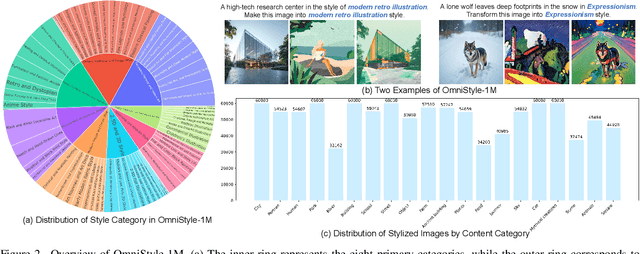
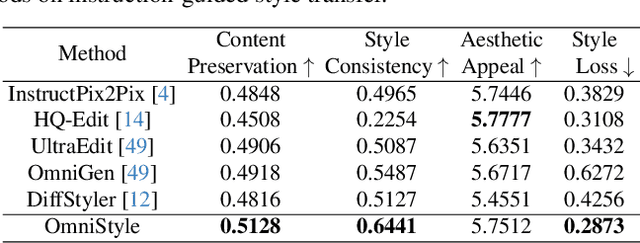

Abstract:In this paper, we introduce OmniStyle-1M, a large-scale paired style transfer dataset comprising over one million content-style-stylized image triplets across 1,000 diverse style categories, each enhanced with textual descriptions and instruction prompts. We show that OmniStyle-1M can not only enable efficient and scalable of style transfer models through supervised training but also facilitate precise control over target stylization. Especially, to ensure the quality of the dataset, we introduce OmniFilter, a comprehensive style transfer quality assessment framework, which filters high-quality triplets based on content preservation, style consistency, and aesthetic appeal. Building upon this foundation, we propose OmniStyle, a framework based on the Diffusion Transformer (DiT) architecture designed for high-quality and efficient style transfer. This framework supports both instruction-guided and image-guided style transfer, generating high resolution outputs with exceptional detail. Extensive qualitative and quantitative evaluations demonstrate OmniStyle's superior performance compared to existing approaches, highlighting its efficiency and versatility. OmniStyle-1M and its accompanying methodologies provide a significant contribution to advancing high-quality style transfer, offering a valuable resource for the research community.
From Zero to Detail: Deconstructing Ultra-High-Definition Image Restoration from Progressive Spectral Perspective
Mar 17, 2025Abstract:Ultra-high-definition (UHD) image restoration faces significant challenges due to its high resolution, complex content, and intricate details. To cope with these challenges, we analyze the restoration process in depth through a progressive spectral perspective, and deconstruct the complex UHD restoration problem into three progressive stages: zero-frequency enhancement, low-frequency restoration, and high-frequency refinement. Building on this insight, we propose a novel framework, ERR, which comprises three collaborative sub-networks: the zero-frequency enhancer (ZFE), the low-frequency restorer (LFR), and the high-frequency refiner (HFR). Specifically, the ZFE integrates global priors to learn global mapping, while the LFR restores low-frequency information, emphasizing reconstruction of coarse-grained content. Finally, the HFR employs our designed frequency-windowed kolmogorov-arnold networks (FW-KAN) to refine textures and details, producing high-quality image restoration. Our approach significantly outperforms previous UHD methods across various tasks, with extensive ablation studies validating the effectiveness of each component. The code is available at \href{https://github.com/NJU-PCALab/ERR}{here}.
Inversion-Free Video Style Transfer with Trajectory Reset Attention Control and Content-Style Bridging
Mar 10, 2025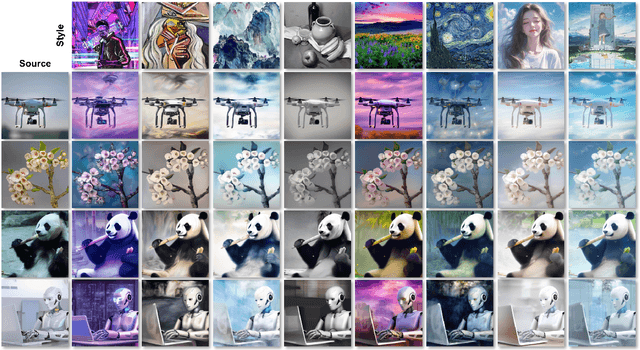

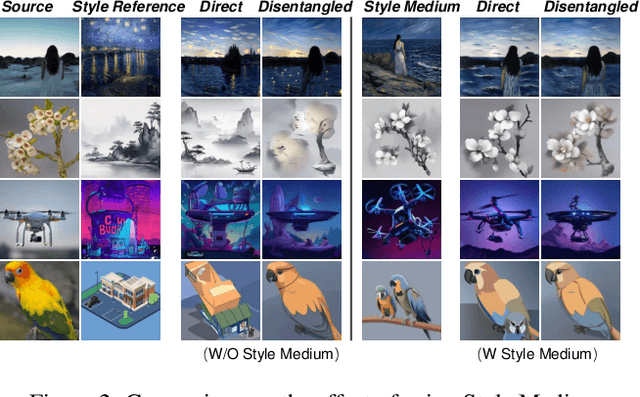

Abstract:Video style transfer aims to alter the style of a video while preserving its content. Previous methods often struggle with content leakage and style misalignment, particularly when using image-driven approaches that aim to transfer precise styles. In this work, we introduce Trajectory Reset Attention Control (TRAC), a novel method that allows for high-quality style transfer while preserving content integrity. TRAC operates by resetting the denoising trajectory and enforcing attention control, thus enhancing content consistency while significantly reducing the computational costs against inversion-based methods. Additionally, a concept termed Style Medium is introduced to bridge the gap between content and style, enabling a more precise and harmonious transfer of stylistic elements. Building upon these concepts, we present a tuning-free framework that offers a stable, flexible, and efficient solution for both image and video style transfer. Experimental results demonstrate that our proposed framework accommodates a wide range of stylized outputs, from precise content preservation to the production of visually striking results with vibrant and expressive styles.
One-Shot Learning for Pose-Guided Person Image Synthesis in the Wild
Sep 15, 2024



Abstract:Current Pose-Guided Person Image Synthesis (PGPIS) methods depend heavily on large amounts of labeled triplet data to train the generator in a supervised manner. However, they often falter when applied to in-the-wild samples, primarily due to the distribution gap between the training datasets and real-world test samples. While some researchers aim to enhance model generalizability through sophisticated training procedures, advanced architectures, or by creating more diverse datasets, we adopt the test-time fine-tuning paradigm to customize a pre-trained Text2Image (T2I) model. However, naively applying test-time tuning results in inconsistencies in facial identities and appearance attributes. To address this, we introduce a Visual Consistency Module (VCM), which enhances appearance consistency by combining the face, text, and image embedding. Our approach, named OnePoseTrans, requires only a single source image to generate high-quality pose transfer results, offering greater stability than state-of-the-art data-driven methods. For each test case, OnePoseTrans customizes a model in around 48 seconds with an NVIDIA V100 GPU.
Barbie: Text to Barbie-Style 3D Avatars
Aug 17, 2024
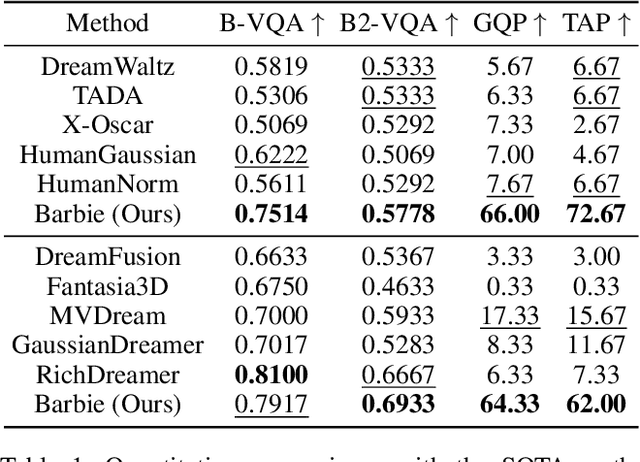

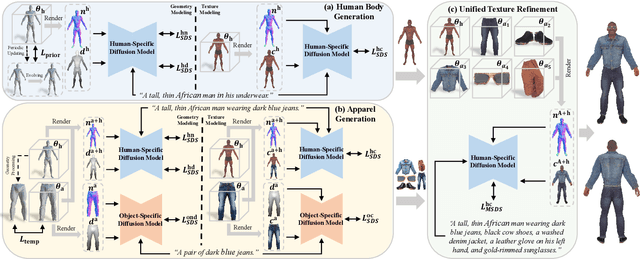
Abstract:Recent advances in text-guided 3D avatar generation have made substantial progress by distilling knowledge from diffusion models. Despite the plausible generated appearance, existing methods cannot achieve fine-grained disentanglement or high-fidelity modeling between inner body and outfit. In this paper, we propose Barbie, a novel framework for generating 3D avatars that can be dressed in diverse and high-quality Barbie-like garments and accessories. Instead of relying on a holistic model, Barbie achieves fine-grained disentanglement on avatars by semantic-aligned separated models for human body and outfits. These disentangled 3D representations are then optimized by different expert models to guarantee the domain-specific fidelity. To balance geometry diversity and reasonableness, we propose a series of losses for template-preserving and human-prior evolving. The final avatar is enhanced by unified texture refinement for superior texture consistency. Extensive experiments demonstrate that Barbie outperforms existing methods in both dressed human and outfit generation, supporting flexible apparel combination and animation. The code will be released for research purposes. Our project page is: https://2017211801.github.io/barbie.github.io/.
Anywhere: A Multi-Agent Framework for Reliable and Diverse Foreground-Conditioned Image Inpainting
Apr 29, 2024Abstract:Recent advancements in image inpainting, particularly through diffusion modeling, have yielded promising outcomes. However, when tested in scenarios involving the completion of images based on the foreground objects, current methods that aim to inpaint an image in an end-to-end manner encounter challenges such as "over-imagination", inconsistency between foreground and background, and limited diversity. In response, we introduce Anywhere, a pioneering multi-agent framework designed to address these issues. Anywhere utilizes a sophisticated pipeline framework comprising various agents such as Visual Language Model (VLM), Large Language Model (LLM), and image generation models. This framework consists of three principal components: the prompt generation module, the image generation module, and the outcome analyzer. The prompt generation module conducts a semantic analysis of the input foreground image, leveraging VLM to predict relevant language descriptions and LLM to recommend optimal language prompts. In the image generation module, we employ a text-guided canny-to-image generation model to create a template image based on the edge map of the foreground image and language prompts, and an image refiner to produce the outcome by blending the input foreground and the template image. The outcome analyzer employs VLM to evaluate image content rationality, aesthetic score, and foreground-background relevance, triggering prompt and image regeneration as needed. Extensive experiments demonstrate that our Anywhere framework excels in foreground-conditioned image inpainting, mitigating "over-imagination", resolving foreground-background discrepancies, and enhancing diversity. It successfully elevates foreground-conditioned image inpainting to produce more reliable and diverse results.
OSTAF: A One-Shot Tuning Method for Improved Attribute-Focused T2I Personalization
Mar 17, 2024Abstract:Personalized text-to-image (T2I) models not only produce lifelike and varied visuals but also allow users to tailor the images to fit their personal taste. These personalization techniques can grasp the essence of a concept through a collection of images, or adjust a pre-trained text-to-image model with a specific image input for subject-driven or attribute-aware guidance. Yet, accurately capturing the distinct visual attributes of an individual image poses a challenge for these methods. To address this issue, we introduce OSTAF, a novel parameter-efficient one-shot fine-tuning method which only utilizes one reference image for T2I personalization. A novel hypernetwork-powered attribute-focused fine-tuning mechanism is employed to achieve the precise learning of various attribute features (e.g., appearance, shape or drawing style) from the reference image. Comparing to existing image customization methods, our method shows significant superiority in attribute identification and application, as well as achieves a good balance between efficiency and output quality.
SemanticHuman-HD: High-Resolution Semantic Disentangled 3D Human Generation
Mar 15, 2024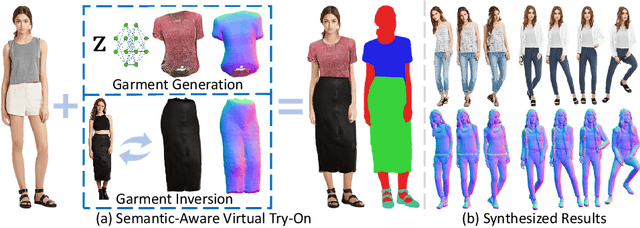
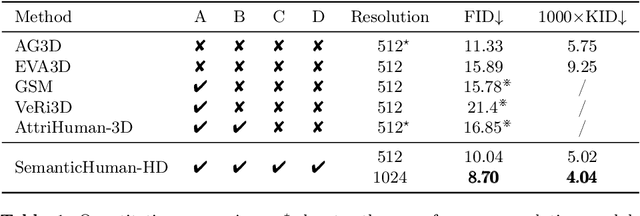
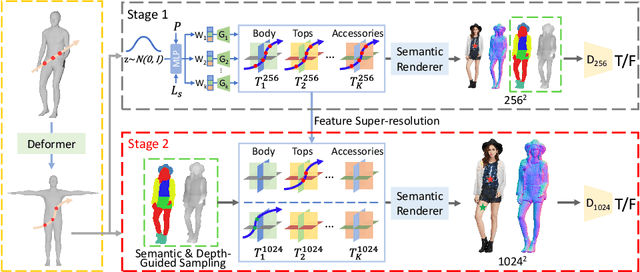

Abstract:With the development of neural radiance fields and generative models, numerous methods have been proposed for learning 3D human generation from 2D images. These methods allow control over the pose of the generated 3D human and enable rendering from different viewpoints. However, none of these methods explore semantic disentanglement in human image synthesis, i.e., they can not disentangle the generation of different semantic parts, such as the body, tops, and bottoms. Furthermore, existing methods are limited to synthesize images at $512^2$ resolution due to the high computational cost of neural radiance fields. To address these limitations, we introduce SemanticHuman-HD, the first method to achieve semantic disentangled human image synthesis. Notably, SemanticHuman-HD is also the first method to achieve 3D-aware image synthesis at $1024^2$ resolution, benefiting from our proposed 3D-aware super-resolution module. By leveraging the depth maps and semantic masks as guidance for the 3D-aware super-resolution, we significantly reduce the number of sampling points during volume rendering, thereby reducing the computational cost. Our comparative experiments demonstrate the superiority of our method. The effectiveness of each proposed component is also verified through ablation studies. Moreover, our method opens up exciting possibilities for various applications, including 3D garment generation, semantic-aware image synthesis, controllable image synthesis, and out-of-domain image synthesis.
ReGANIE: Rectifying GAN Inversion Errors for Accurate Real Image Editing
Jan 31, 2023



Abstract:The StyleGAN family succeed in high-fidelity image generation and allow for flexible and plausible editing of generated images by manipulating the semantic-rich latent style space.However, projecting a real image into its latent space encounters an inherent trade-off between inversion quality and editability. Existing encoder-based or optimization-based StyleGAN inversion methods attempt to mitigate the trade-off but see limited performance. To fundamentally resolve this problem, we propose a novel two-phase framework by designating two separate networks to tackle editing and reconstruction respectively, instead of balancing the two. Specifically, in Phase I, a W-space-oriented StyleGAN inversion network is trained and used to perform image inversion and editing, which assures the editability but sacrifices reconstruction quality. In Phase II, a carefully designed rectifying network is utilized to rectify the inversion errors and perform ideal reconstruction. Experimental results show that our approach yields near-perfect reconstructions without sacrificing the editability, thus allowing accurate manipulation of real images. Further, we evaluate the performance of our rectifying network, and see great generalizability towards unseen manipulation types and out-of-domain images.
 Add to Chrome
Add to Chrome Add to Firefox
Add to Firefox Add to Edge
Add to Edge